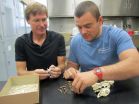(Press-News.org) In a new study, scientists have gathered all available NASA/ESA Hubble Space Telescope data on the four outer moons of Pluto to analyse the system in more depth than ever before. The observations show that at least two of Pluto's moons are not neatly rotating on their axes but are in chaotic rotation while orbiting around Pluto and its companion Charon. The study also hints that one of the moons has a mysterious jet-black colouring. These surprising results appear in the 4 June issue of the journal Nature.
Almost every moon in the Solar System, including our moon, rotates on its axis at the same speed as it orbits its parent body. It is for this reason that we always see the same side of the moon facing us on Earth. On Pluto, however, astronomers have now discovered that there are no hidden sides to its moons.
In a surprising new study, it has been found that two of Pluto's moons, Nix and Hydra, are in a chaotic rotation. This means that an observer on Pluto would not see the same face of the moons from one night to the next. For visitors on the moons themselves, things would get even more confusing, as every day would be a different length to the one that preceded it.
The other two moons studied, Kerberos and Styx, will likely be found to be chaotic too, pending further study.
'Prior to the Hubble observations, nobody appreciated the intricate dynamics of the Pluto system,' explains Mark Showalter of the Search for Extraterrestrial Intelligence (SETI) Institute in California, USA, and main author of the study.
The chaotic motion of the moons is caused by the system's two central bodies, Pluto and Charon [1]. 'These two bodies whirl around each other rapidly, causing the gravitational forces that they exert on the small nearby moons to change constantly,' explains Doug Hamilton, co-author of the study. 'Being subject to such varying gravitational forces makes the rotation of Pluto's moons very unpredictable. The chaos in their rotation is further accentuated by the fact that these moons are not neat and round, but are actually shaped like rugby balls!'
The movement of the moons in the Pluto-Charon system offers valuable insights into how planets orbiting a double star might behave. 'We are learning that chaos may be a common trait of binary systems,' Hamilton continues. 'It might even have consequences for life on planets orbiting binary stars.'
Clues to the Pluto system chaos first came when astronomers measured variations in the light reflected off of the two small moons. Looking at images taken by Hubble between 2005 and 2012, the brightness was found to change unpredictably -- instead of following a regular cycle -- in a way that could only be explained by chaotic movement.
These images also showed that the moon Kerberos is charcoal-black in colour, a stark contrast to the bright white of the other moons. It was predicted that pollution from dust blasted off the satellites by meteorite impacts would coat the moons, giving their surfaces a homogenous look, but why Kerberos is black is a mystery.
The chaotic rotation of the moons was not the only surprise that arose from the study; Hubble's monitoring also revealed a connection between the orbits of the three moons Nix, Styx, and Hydra.
'Their motion is tied together in a way similar to that of three of Jupiter's large moons,' noted Doug Hamilton of the University of Maryland, co-author of the study. 'If you were sitting on Nix, you would see Styx go around Pluto twice every time Hydra goes around three times.'
The chaotic movements found in this fascinating system do not necessarily mean that it is on the brink of flying apart. More studies are needed to determine the long-term fate of the Pluto system.
The researchers agree that a combination of monitoring data from Hubble, a close-up look from NASA's New Horizons space probe, which flies by the system in July 2015 [2], and, eventually, observations with the NASA/ESA/CSA James Webb Space Telescope (http://sci.esa.int/jwst/) will help to settle some of the many mysteries of the Pluto-Charon system.
'Pluto will continue to surprise us when New Horizons flies past it in July,' Showalter said. 'Our work with Hubble just gives us a foretaste of what's in store.'
Notes
[1] Due to Charon's large size, Pluto and Charon orbit about a common centre of gravity that is located in the space between the bodies. Our moon has one eightieth of Earth's mass, whereas Charon has one eighth of Pluto's mass.
[2] NASA's New Horizons space probe was launched in 2006 to study Pluto, its moons, and other Kuiper belt objects. It will fly past the Pluto-Charon system on 14 July 2015 and will produce detailed surface maps of Pluto and all of its moons.
INFORMATION:
More information
Images of Hubble - http://www.spacetelescope.org/images/archive/category/spacecraft/
Link to hubblesite release - http://hubblesite.org/newscenter/archive/releases/2015/24
Link to science paper - http://www.spacetelescope.org/static/archives/releases/science_papers/heic1512a.pdf
Contacts:
Mark R. Showalter
mshowalter@seti.org
650-810-0234
SETI Institute
Doug Hamilton
dphamil@astro.umd.edu
301-405-1548
Department of Astronomy, University of Maryland
Mathias Jäger
mjaeger@partner.eso.org
49-176-623-9750
ESA/Hubble
SALT LAKE CITY, June 4, 2015 - At times during the past 10,000 years, cottontails and hares reproduced like rabbits and their numbers surged when the El Niño weather pattern drenched the Pacific Coast with rain, according to a University of Utah analysis of 3,463 bunny bones.
The study of ancient rabbit populations at a Baja California site may help scientists better understand how mammals that range from the coast to the interior will respond to climate change, says anthropology doctoral student Isaac Hart. He is first author of the study to be published in the ...
A rare and elusive rabbit has been found, held and photographed by a researcher from the University of East Anglia (UEA).
The Annamite Striped rabbit, found in the forests of Laos and Vietnam, was first documented by rabbit expert Dr Diana Bell and colleagues from UEA's School of Biological Sciences in the journal Nature in 1999. It has rarely been seen since.
Researcher Sarah Woodfin, who is studying for a Masters in Applied Ecology and Conservation at UEA, set out on a three-month expedition to track the recently-discovered rabbit and study its habitat.
But she ...
Many aquatic species have a reputation for negligent parenting. Having cast their gametes to the currents, they abandon their offspring to their fate. However, hands-on parenting is taken to a whole new dimension in the Syngnathidae fish family. Instead of leaving the responsibility to the females, seahorse and pipefish males take the pledge to care for their young even before the eggs are fertilized. The females depart soon after placing their eggs directly into the male's brood pouch, leaving the soon-to-be fathers to incubate the developing embryos. Ines Braga Goncalves ...
Cancer has overtaken cardiovascular disease, which includes heart disease and stroke, as the UK's No 1 killer--but only among men, reveals research published online in the journal Heart.
Cardiovascular disease is still the most common cause of death among women, and kills more young women than breast cancer, the figures show.
The researchers used the latest nationally available data (2012-13) for each of the four UK countries and the Cardiovascular Disease Statistics 2014 report compiled for the British Heart Foundation (BHF) to quantify the prevalence of cardiovascular ...
Researchers have developed a score that predicts an individual's risk of dying within 5 years for people aged between 40 and 70 years old in the UK, according to new research published in The Lancet.
The score, which uses measures that can be obtained by simple questionnaires without any need for physical examination, such as self-rated health and usual walking speed, could be used by individuals to improve awareness of their health status, and by doctors to identify high-risk individuals for further treatment, say the authors.
Individuals can calculate their personalised ...
Women aged 50-69 years who attend mammography screening reduce their risk of dying from breast cancer by 40 per cent compared to women who are not screened - according to a major international review of the latest evidence on breast cancer screening.
Overall, women who are invited to attend mammography screening have a 23 per cent risk reduction in breast cancer death (owing to some attending and some not), compared with women not invited by routine screening programmes.
In the UK, this relative risk translates to around eight deaths prevented per 1,000 women regularly ...
ANN ARBOR, Mich. - Day in and day out, for years on end, millions of people with diabetes prick their fingers to test their blood sugar level. And many may wonder if all the careful eating, exercise and medication it takes to keep those levels under control is really worth it.
A major new study should encourage them to keep going for the long haul, to protect their hearts from diabetes-related damage. But it should also prompt them to work with their doctors on other ways to reduce their cardiovascular risk.
The key finding: that keeping blood sugar levels under good ...
Boston, MA - A new study by researchers at Harvard T.H. Chan School of Public Health found that death rates among people over 65 are higher in zip codes with more fine particulate air pollution (PM2.5) than in those with lower levels of PM2.5. It is the first study to examine the effect of soot particles in the air in the entire population of a region, including rural areas. The harmful effects from the particles were observed even in areas where concentrations were less than a third of the current standard set by the Environmental Protection Agency (EPA).
"Most of the ...
Operation IceBridge wrapped up its seventh Arctic deployment on May 21, when NASA's C-130 research aircraft with the mission's researchers and instruments on board departed Thule Air Base in Greenland and headed to NASA's Wallops Flight Facility in Virginia.
This Arctic field season, IceBridge, NASA's twice-yearly airborne survey of polar ice, carried out 33 eight-hour flights during ten weeks, collecting data over sea and land ice regions that have been evolving rapidly over the last decades. The mission also conducted over a dozen international research collaborations ...
Researchers at the University of Toronto (U of T) have uncovered new insights on the genetic causes of Amyotrophic Lateral Sclerosis (ALS), which is also known as Lou Gehrig's disease. These findings could uncover a new way to detect a genetic predisposition to ALS before the disease strikes.
A common mutation associated with ALS is an unstable repeated DNA sequence within the C9orf72 gene that could reach into the thousands. However, it is unknown how many repeats would be sufficient to cause the disease. A way to predict if the number of repeats increases to the damaging ...


